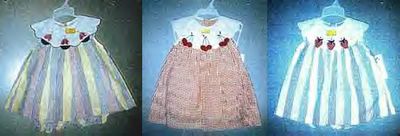CAFC Affirms TTAB's Slokevage Product Design Trade Dress Ruling
In a precedential opinion, the U.S. Court of Appeals for the Federal Circuit affirmed the TTAB's decision in In re Slokevage, Serial No. 75602873 (November 10, 2004) [not citable], reconsideration denied, February 4, 2005. [TTABlogged here and here]. The Court concluded that substantial evidence supported the Board's finding that Slokevage's trade dress was product design and thus could not be inherently distinctive, and that her trade dress was not unitary and therefore the PTO's requirement of a disclaimer of the "cut-out areas" was proper. In re Slokevage, 78 USPQ2d 1395 (Fed. Cir. 2006).
Joanne Slokevage sought to register, for "pants, overalls, shorts, culottes, dresses, skirts," a "configuration" consisting of a label with the words "FLASH DARE!" and cut-out areas on each side of the label. The cut-out areas are located in the rear of the garment and each comprises a hole and a flap with a closure device.
The Board found that the cut-out areas (the holes and flaps) constituted product design. Relying on Wal-Mart Stores, Inc. v. Samara Bros., Inc., 529 U.S. 205, 54 USPQ2d 1065, 1069 (2000), it ruled that Slokevage's trade dress could not be registered absent proof of secondary meaning.
On appeal, Slokevage contended that whether trade dress is product design or not is a "legal" issue. The court, in a question of first impression, ruled that "the determination whether trade dress is product design is a factual finding." Likewise, "the inquiry into whether a mark is unitary is a factual determination." Consequently, the court reviewed the Board's rulings on these two issues to see if they were supported by substantial evidence.
Slokevage argued that her trade dress is not product design and thus it can be inherently distinctive. She (cheekily?) attempted to distinguish Wal-Mart by pointing out that the trade dress in Wal-Mart implicated the overall appearance of the product whereas her trade dress involves only a component of a product design. Moreover, her mark is located on the rear of the garment, where trademarks are often found.

The CAFC, however, agreed with the Board: "while Slokevage urges that product design trade dress must implicate the entire product, we do not find support for that proposition. Just as the product design in Wal-Mart consisted of certain design features featured on clothing, Slokevage's trade design similarly consists of design features, holes, and flaps, featured in clothing, revealing the similarity between the two types of design."
The court found the reasoning in Wal-Mart to be instructive here:
"unlike a trademark whose 'predominant function' remains source identification, product design often serves other functions, such as rendering the 'product itself more useful or more appealing.' Wal-Mart, 529 U.S. at 212, 213. The design at issue here can serve such utilitarian and aesthetic functions. For example, consumers may purchase Slokevage's clothing for the utilitarian purpose of wearing a garment or because they find the appearance of the garment particularly desirable. Consistent with the Supreme Court's analysis in Wal-Mart, in such cases when the purchase implicates a utilitarian or aesthetic purpose, rather than a source-identifying function, it is appropriate to require proof of distinctiveness."
Moreover, even if this were a close case, Wal-Mart requires that in close cases the trade dress be classified as product design.
As to the disclaimer issue, the court noted that for a unitary mark, a disclaimer of a portion of the mark is not appropriate. Here, however, the court agreed with the Board that the mark is not unitary. "The display of the elements in the drawing of the trade dress, the applicant's earlier registration of the words 'FLASH DARE!,' and the applicant's design patent on the cut-out area are evidence that Slokevage's trade dress is not unitary."
Because it found that substantial evidence supported the TTAB's rulings, the CAFC affirmed.
TTABlog comment: Not much of a surprise here. The CAFC was not about to let this applicant cut a hole in the fabric of Wal-Mart. So I guess Ms. Slokevage will just have to grin and bare it.
Text Copyright John L. Welch 2006.


0 Comments:
Post a Comment
<< Home